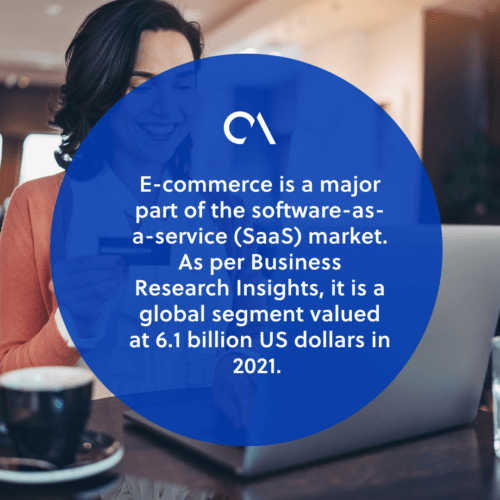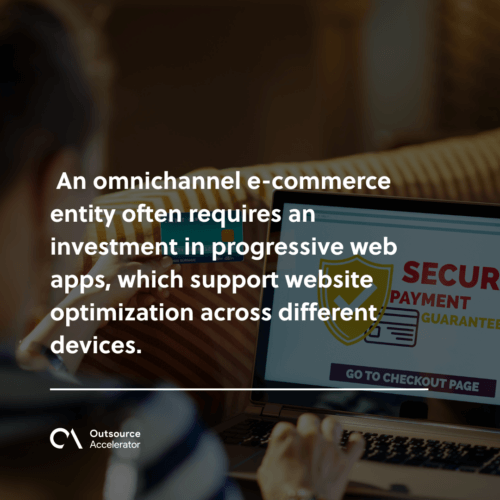Step up your e-commerce website development strategy

From essentials to luxury items, almost everything can now be bought online. Thanks to the rise of e-commerce platforms, buyers and sellers are connected with greater convenience.
Consumers are more incentivized to make purchases without the need to run to the store. More importantly, e-commerce has allowed small brands to reach their market and grow in a competitive landscape.
However, it also changed how brands compete. One part of the battle is the website, which is essentially the digital equivalent of a storefront. A Stanford study shows that about 75% of your brand credibility is tied to your website design.
This article will help you take your e-commerce website development strategy to the next level.
Ways to start your e-commerce website
With the available technology, anyone can start an e-commerce platform of their own. You can sum up these strategies into three methods:
1. Build on an e-commerce platform
E-commerce is a major part of the software-as-a-service (SaaS) market. As per Business Research Insights, it is a global segment valued at 6.1 billion US dollars in 2021.
Boasting the greatest convenience, business owners only need to pay a subscription fee. It covers access to the service provider’s assets and hosting the website.
Shopify, BigCommerce, and SalesForce Commerce Cloud are some of the most common examples of SaaS ecommerce. The service provider oversees the platform’s upkeep, security, and product upgrades. This makes this option one of the best services to outsource for e-commerce businesses.
2. Start on a MACH architecture
MACH refers to Microservices, API-first, Cloud-native SaaS, and Headless. It is generally summarized as a set of best practices for building enterprise software in a composable manner.
Unlike a fixed setup with SaaS e-commerce, MACH architecture allows you to choose different modular tools and combine them to get the desired effect.
This allows you to integrate and remove parts, tools, and services as needed. MACH-based e-commerce websites enjoy unprecedented flexibility to adapt to a rapidly-changing market.
3. Build your own website
The previous methods refer to accessing pre-made services and features. Meanwhile, this option lets you customize everything as you see fit. It is more attainable if you have sufficient web development experience or an IT team in place.
Traditionally, web developers had to build entire websites from scratch. Nowadays, you have the option to try open-source e-commerce platforms. You can access the source codes and modify all aspects of your website.
However, one catch with building your own e-commerce website is that you are usually in charge of maintenance, including PCI compliance and cybersecurity.
Still not confident about building your own? You can enlist the aid of a developer like Itransition, which has over 20 years in the e-commerce sphere.

Deciding on functionalities to include on your website
Aside from the design and the aesthetic of your e-commerce website, another important part is the functionalities.
You can choose from hundreds, if not thousands, of possible website functions. As fun as it might sound, you can’t cram all those features into a single website.
You’ll need to choose what to include, and the following steps might help you decide:
- Start with the essentials, such as payment and marketplace integrations
- Identify services that are aligned with your business goals
- Sort these services in order of priority
- Identify existing web development tools and functionalities that would translate your services
E-commerce website development trends you shouldn’t miss
E-commerce website trends emerge for a reason, and that is because they positively impact online businesses. For example, improving customer retention and session duration or streamlining the purchasing method are small efforts that ultimately drive revenue.
To make sure you don’t miss out on bankable opportunities, here are some of the trends you can consider:
Increased AI usage
The rapid rise of artificial intelligence may have been divisive, but there’s no denying what it can do for you and your e-commerce website. They can now be used to generate bodies of text or even bits of computer code.
In a more entrepreneurial setting, AI can generate product recommendations and draw market projections.
Omnichannel selling
Being an omnichannel provider means you get to reach more customers. Connecting with as many customer touchpoints improves accessibility and positively influences the purchasing decision.
Being an omnichannel e-commerce entity often requires an investment in progressive web apps, which support website optimization across different devices.
Introducing gamification
Gamification played a big role in improving the user experience. By adding basic elements like tasks and rewards, website visitors are motivated and engaged.
In an e-commerce setting, this can range from loyalty programs to referral incentives. Similarly, you can add small games or periodic leaderboards as welcome entertainment to your website visitors.
Virtual/ augmented realities
AR/VR is becoming increasingly popular in certain markets. By fully immersing customers in your product, they can experience what you offer despite not being physically there. While it requires a bit more technology and resources, it pays for itself when done right.
For example, real estate brokers or Airbnb operators can help visitors visualize the product offered and better understand their options.

Outsource e-commerce website development
E-commerce is a fast-changing field, requiring both web developers and entrepreneurs to keep up with the current trends and best practices. Staying updated means staying relevant, which could spell the business’s survival and growth.
While not everyone has the skill set to build their own website, anyone can access top-quality designs and functionalities thanks to outsourced services. With the right provider, you can execute your vision and gain an advantage over your competitors.







 Independent
Independent




